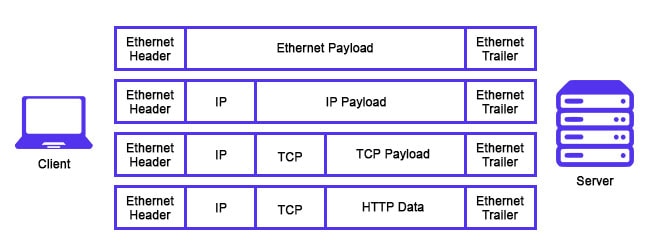
So, what is an internet protocol (IP)? Let me start by providing you with the technical definition of your question. The Internet Protocol or commonly known as “IP” is a set of requirements or instructions for routing packets of data traveling thru a network. These rules direct these packages of data into their correct destination. In other words, IP is directions to move data from one side to another.
Firstly, for this information to travel efficiently and reach its intended destination. It’s certain that all data sent over the internet should be divided into smaller sections called packets. These chunks of data received protocol information that instructs routers to send packets to the right location.
Components of the Internet Protocol Datagram
- IP Identification (IPID) Used to uniquely identify IP datagrams and for reassembly of fragmented packets.
- Time-to-live (TTL) Attempts to keep datagrams and packets from routing in circles. When TTL reaches 0, the datagram is dropped. The TTL allows traceroute to function, identifying each router in a network by sending out datagrams with successively increasing TTLs, and tracking when those TTLs are exceeded.
- Protocol Describes the higher-level protocol embedded within the datagram.
- Source IP Address The IP address of the host where the datagram was created.
- Destination IP Address The destination where the datagram should be sent.
How does internet protocol work?

I understand that not everybody learns the same way. As a result, this technical definition might not stick with you. That is to say, let me try to use a real-world analogy to explain the internet protocol and the internet model.
Imagine you are relocating your family to a new city.
- Data Layer: All the stuff in your house represents the network data.
- Link Layer: The roads to the new house represent the network topology, ethernet, or cable system.
- Network Layer: The moving truck represents the Internet Protocol (IP).
- Transport Layer: All the moving boxes represent the packages of TCP or UDP package of data going inside the moving truck.
- Application Layer: Whatever is inside the boxes represents the application information like HTTP, FTP, SSH, etc.
- IP Address: Represents the address of the new house.
- Port Numbers: is represented by the rooms in the house.
What is an IP packet?
In computer networks jargon, an IP packet is a container or package that carries data over a TCP/IP network. This type of packages is often carried as the payload inside an Ethernet frame. A frame that contains the packages source and destination MAC addresses in the header.
An IP header is composed of a series of pieces of information about the packet. Above all, his information contains the senders and receiver IP address. This information includes;
- Header length
- Length of the packet
- The number of networks hops
- Protocol type (TCP, UDP, etc.)
What is the Transmission Control Protocol or TCP/IP?
The TCP/IP networking model defines the process for a computer network to work. This networking model breaks the functions into a small number of categories called layers. Most importantly, the most popular TCP/IP application today is the web browser.
TCP/IP is similarly to sending someone a message written on lego blocks over the mail. Consequently, each piece then can travel through a different route, subsequently some of which take longer than others. In other words, the Lego blocks will arrive out of order.
User Datagram Protocol or UDP
Most importantly, UDP is a communications protocol that facilitates the exchange of messages between computing devices in a network. It’s an alternative to the transmission control protocol (TCP). In a network that uses the Internet Protocol (IP), it is sometimes referred to as UDP/IP.
First of all, UDP divides messages into packets called datagrams. Secondly, it can then be forwarded by network switches or routers. It’s important to know that UDP includes the port numbers in the datagram header. Port numbers that help identify different user requests. This is done by its checksum capability that helps verify the integrity of the data transferred.
How does IP routing work?
The Internet is made up of interconnected networks responsible for certain blocks of IP addresses. These types of networks are commonly known as autonomous systems or AS.
The routers keep track of all devices in a network. This is done by saving the device information in a routing table. Consequently, this information allows routers to forwards data packets between networks. In other words, packets travel from router to router until one claims responsibility for the targeted location.






